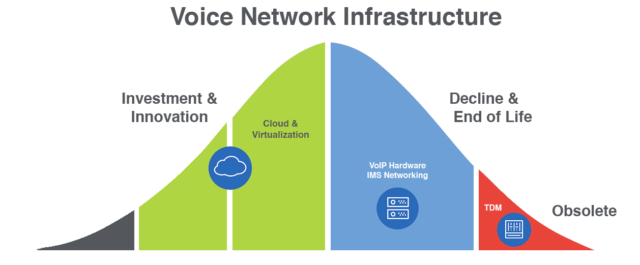Cloud services are the new normal for businesses, with market revenue expected to surpass $49 billion by 2023.1As IT teams opt to host less hardware on-premises, SMBs and enterprises are increasingly diverting more budget dollars to cloud apps and platforms — and phone and communication systems are no exception. While the concept and benefits of cloud communications are not new, the COVID-19 pandemic has created an unprecedented market opportunity for service providers and SMBs.
1. Increase Revenue in a Saturated Market
Cloud phone solutions have a natural advantage in the business communications ecosystem because they’re delivered through an internet connection instead of a copper-wire phone line. Remote provisioning offers immense flexibility since the voice features aren’t limited to the type of server and number of ports available through in-office systems — any number of auto-attendants, extensions, voicemail boxes, and conference bridges can be set up as needed for an end user’s organizations.
The advantages of cloud-based phones over traditional phone systems include substantial savings opportunities for end users. VoIP can decrease the initial costs for start-ups by 90%, local calls by 40%, and international calls by 90%. In a saturated market, being able to offer savings like that is incredible! 2
Offering a broader portfolio of services creates growth opportunities within an existing customer base and the ability to win net new business customers. A turnkey cloud communication platform provides a powerful base to service virtually any business, regardless of industry, because it allows service providers to target any range of customers with assurance their solution infrastructure will integrate with the end customer’s applications and infrastructure.
2. Reduce Time and Effort
Remote deployment capabilities allow service providers to offer businesses of any size the ability to manage communication services in a less costly, more streamlined manner. Rather than placing management responsibility solely on the service provider, end users are empowered with the tools to self-manage their communication solution without the cost of an expensive capital outlay or premium white-glove service. End users can use the online portal to set up and configure new employees with devices, extensions, and other services, no matter if they’re located in the same office or another country.
3. Protect and Leverage Existing Infrastructure
Cloud communication solutions have advanced interoperability features that integrate with a service provider’s existing cable operator, internet service provider (ISP), and devices. Of course, maintaining and expanding interoperability is vital for service providers. As end users grow or optimize their operations, they will adopt new applications and systems with the expectation that their new solutions will work in conjunction with their existing ones.
By incorporating a full-stack cloud communications solution into an existing product portfolio, service providers can offer an all-in-one solution that provides tested and vetted interoperability with not only their existing infrastructures but also their end users’ infrastructures. Service providers who offer cloud communication solutions are well-positioned for growth opportunities and unexpected industry disruptions (like COVID-19).

4. Expand Commercial Longevity
Developing a new solution for an existing suite is extremely time and capital-intensive. Development alone can take years of engineering and product resources, not to mention the actual product launch which can require countless marketing and sales assets, cross-departmental coordination, budgeting, timed market releases, and more.
Aging telecom infrastructure is a significant concern for service providers. Given the significant upfront investment and required ongoing maintenance costs, it is often infeasible for service providers to undertake the development of a new product offering. Even for those who take the leap, gaining approval, raising capital, and ensuring compliance can take years. It’s easy to miss important windows of opportunity.
Service providers who expand their product suite to include a cloud communications platform eliminate most of those hurdles. Additionally, cloud platforms handle all the time and knowledge-intensive system maintenance and software updates. Most importantly, with the absence of extensive hardware demands, it’s easy to sell these solutions to end users.
5. Protect Margins
With a traditional on-premises telephony system, advanced planning requirements, higher setup and hardware maintenance costs, and reliance on IT support all cut into a service provider’s margins. Of course, this only accounts for the upfront effort required to get a customer up and running. Best-in-class cloud communication systems bypass all these expenses with a no upfront CAPEX model that eliminates the cost of expensive hardware and installation. This not only protects the service provider’s margins and reduces acquisition costs, but also broadens the range of SMBs who are able to afford it.
Aside from unpredictable disruptions like COVID-19, it’s rare for any business to operate at the same size for very long. As end users’ businesses grow, they may have to adapt an existing phone system to accommodate new lines for new employees or invest capital to purchase and maintain additional PBXs for a new office.
With a cloud communications system, both service providers and their customers benefit from the ability to scale solution licenses up — or down — as needed. Service providers can avoid the risk of over, or under, purchasing by directly matching demand to product availability. Predictable margins mean that pricing stability can be passed down to end users for an enhanced customer experience.
6. IT Sustainability with Automation
Automation and IT sustainability are not just a concern for large enterprises. One survey asked more than 300 IT professionals, 87% of whom work at organizations with more than 1,000 employees, “What part of your communications user setup/provisioning would you automate if you could?” 3
Respondents favored automating all four options with the same weighting: Provisioning for instant messaging, video conferencing, telephony, and email each received between 50% and 54% of votes (multiple choices allowed).2This suggests that automation is a general preference for IT, regardless of the specific technology. 4
On-premises telephony infrastructure traditionally struggles to keep up with emerging automation technology and requires a significant amount of knowledge, time, and effort to maintain or change. For example, with an on-premises solution, end users must synchronize with their service provider to coordinate interoperability and device upgrades, compatibility, deployment dates, end-of-life, and maintenance expectations.
With a cloud communication system, service providers are freed from the time and effort needed to facilitate those changes. Automatic distribution of new software updates through multiple channels ensures end users always have the latest security updates, compliance measures, and next-gen technology, without the need for intervention and maintenance from their service provider.

What a Cloud Communication Solution Means for Users
SMBs and enterprises are motivated to make the change to cloud communication solutions because technology advancements have made cloud-based phone solutions highly sustainable, cost-effective, all-inclusive, and flexible — all of which is revolutionizing markets and enabling rapid growth that in-office phone solutions can’t keep pace with.
End users are looking for an adaptable, feature-rich system that will grow with them. Cloud communication systems are extremely adaptable and offer the tools end users need to tackle greater demands and higher expectations:
- Easy management through a single platform with an online user interface.
- Flexible employee collaboration from inside or outside the office.
- Reduced administration and maintenance costs.
- Integration and interoperability with mission-critical business applications.
- Expandable operations and solution suite with minimal hardware.
To learn more about how a phone system in the cloud can increase revenue, automate end customer onboarding and management, talk to an Alianza representative today.
Learn more: Cloud Phone Systems — 9 Transformative Benefits for Service Providers


